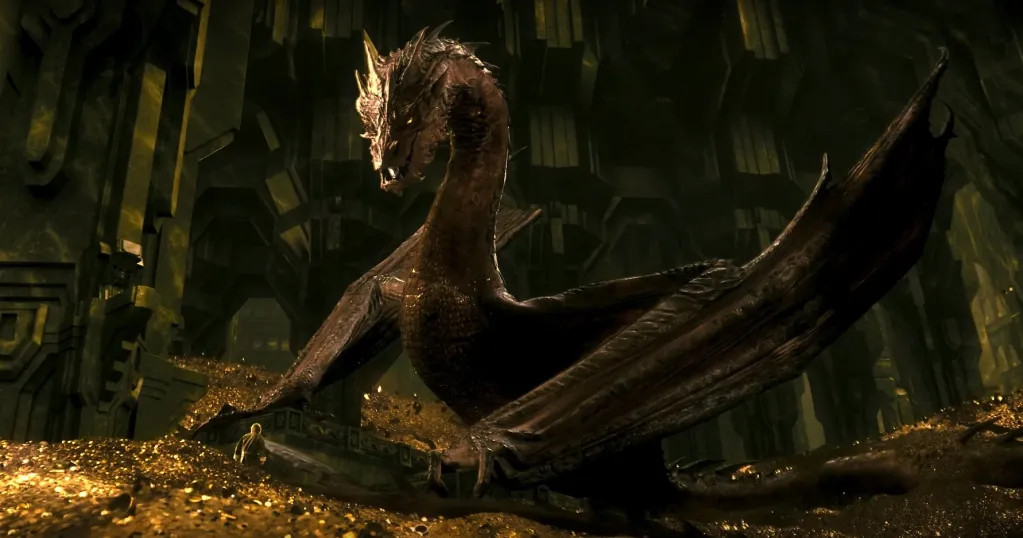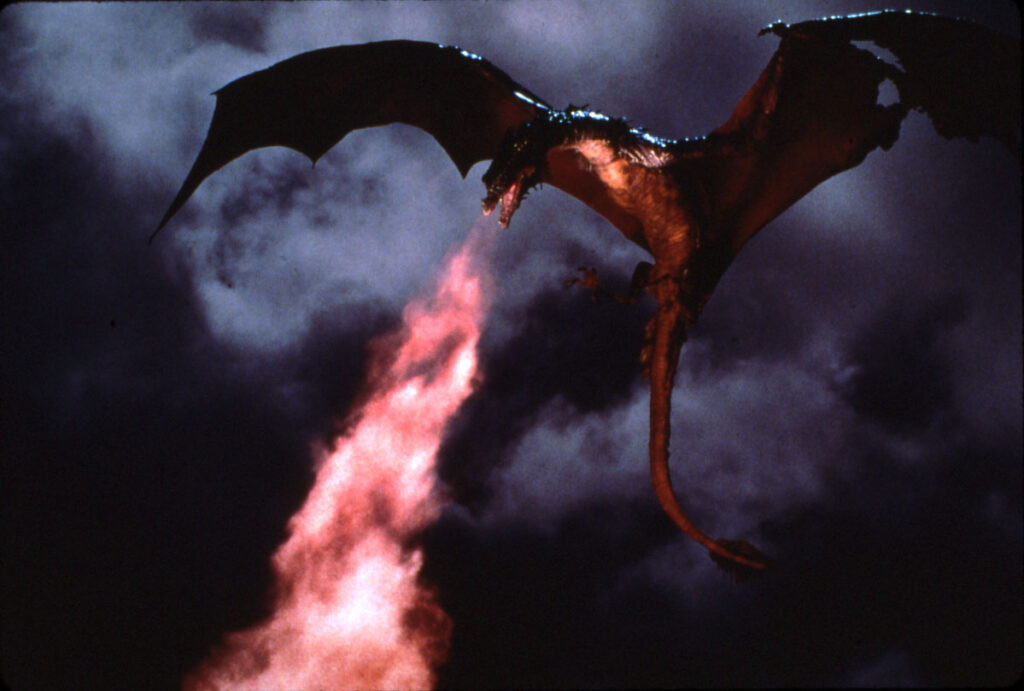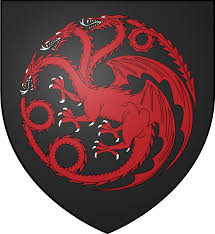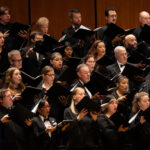The roar of dragons in the latest episode of HOUSE OF THE DRAGON, “The Red Dragon and the Gold,” has undoubtedly ignited conversations among fans. The clash of dragons in the skies above Rook’s Rest was a spectacle, a thrilling aerial battle that many had eagerly anticipated. While comparisons to other dragon-filled fantasy worlds might arise – perhaps even REIGN OF FIRE with its multitude of dragons – there’s a unique intensity to the dragon battles in A Song of Ice and Fire. These aren’t just scaled monsters; they are powerful, nuanced creatures that are deeply interwoven into the fabric of George R.R. Martin’s world.
Dragons, though creatures of myth and legend, hold a powerful grip on our imaginations. Across cultures and throughout history, dragon-like figures appear in folklore and stories. Some theories suggest these myths were sparked by the discovery of dinosaur bones, fueling tales of colossal beasts. Regardless of their origin, dragons have become a cornerstone of the fantasy genre, captivating readers and viewers for generations. And for George R.R. Martin, this fascination runs deep.
Even his very name, George, echoes the legendary dragonslayer St. George, a figure still revered today. Martin’s connection to dragons extends far beyond a name; he penned his own dragon stories, like “The Ice Dragon” and “The Way of Cross and Dragon,” long before the sprawling saga of A Song of Ice and Fire took shape. These early works were a precursor to the meticulously crafted dragons that would populate Westeros and Essos.
The depiction of dragons varies wildly across cultures and fantasy universes. Eastern dragons, particularly those of Chinese lore, are often depicted as benevolent, wingless beings associated with luck and prosperity. Western dragons, in contrast, are traditionally fire-breathing terrors, harbingers of destruction. Modern fantasy literature has further diversified the dragon archetype. From the noble dragons of ERAGON to the endearing Toothless from HOW TO TRAIN YOUR DRAGON, the spectrum of dragon personalities and characteristics is vast.
 Toothless the Dragon from How to Train Your Dragon, showcasing a friendly and approachable dragon design, contrasting with traditional fearsome depictions.
Toothless the Dragon from How to Train Your Dragon, showcasing a friendly and approachable dragon design, contrasting with traditional fearsome depictions.
Tolkien’s dragons in The Lord of the Rings and The Hobbit occupy a darker space, embodying evil and serving as agents of Morgoth and Sauron, akin to his orcs and trolls. Smaug, the formidable dragon in The Hobbit, exemplifies this archetype. He is intelligent, capable of speech, and possessively guards a vast hoard of gold, a classic dragon trait. Smaug’s portrayal set a benchmark for dragon depictions in fantasy.
 Smaug from The Hobbit movie, a large, imposing dragon covered in golden scales, perched atop a mountain of treasure, highlighting the classic depiction of dragons as hoarders of gold.
Smaug from The Hobbit movie, a large, imposing dragon covered in golden scales, perched atop a mountain of treasure, highlighting the classic depiction of dragons as hoarders of gold.
Before the CGI spectacle of Smaug, Vermithrax Pejorative from the film DRAGONSLAYER was considered by many to be the pinnacle of cinematic dragons. Vermithrax, with its two legs and two wings, embodied a raw, dangerous, fire-breathing creature of instinct, devoid of speech or gold hoarding. This dragon served as a significant inspiration for many fantasy authors and dragon enthusiasts.
 Vermithrax Pejorative from Dragonslayer movie, a realistic and menacing dragon with two legs and two wings, perched on rocky terrain, emphasizing a grounded and less fantastical dragon design.
Vermithrax Pejorative from Dragonslayer movie, a realistic and menacing dragon with two legs and two wings, perched on rocky terrain, emphasizing a grounded and less fantastical dragon design.
At the other end of the spectrum lies the dragon from DRAGONHEART, voiced by Sean Connery. This dragon is portrayed as a benevolent, four-legged, talking creature who befriends the hero. While offering a different take on dragons, it’s often considered a less compelling and less impactful dragon in a film of lesser quality compared to others.
In crafting A Song of Ice & Fire, Martin aimed to fuse the enchanting elements of epic fantasy with the gritty realism found in historical fiction. Magic exists in his world, but it’s deliberately less prevalent than in many other fantasy settings. Drawing inspiration from Tolkien’s relatively low-magic Middle-earth, Martin sought to ground Westeros in a sense of historical authenticity, evoking the atmosphere of the Crusades, the Hundred Years’ War, and the Wars of the Roses. This commitment to realism extended to his dragons.
Influenced in part by his friendship with the late Phyllis Eisenstein, a celebrated fantasy and science fiction author, Martin envisioned dragons that, while fantastical, felt as tangible and believable as possible. He meticulously designed his dragons, adhering to specific biological principles. Flight and fire-breathing were essential, but so was anatomical accuracy. His dragons possess two legs and two wings – large, powerful wings capable of lifting their massive bodies. Martin firmly rejects the four-legged dragon design, pointing out that no Earth creature has ever possessed six limbs. Birds, bats, and pterodactyls all adhere to the two legs and two wings configuration.
The confusion surrounding dragon leg count often stems from medieval heraldry. Initially, both two-legged and four-legged dragons appeared on heraldic shields and banners. However, as heraldry became more standardized, a distinction emerged: four-legged creatures were labeled “dragons,” while two-legged versions were termed “wyverns.” This distinction, however, is largely arbitrary, born from artistic and heraldic conventions rather than zoological reality, especially considering neither creature existed outside of legend.
Dragons are, undeniably, real within the world of Westeros (and wyverns exist in Sothoryos). Therefore, Westerosi heraldry, in Martin’s view, should reflect this reality. The Targaryen sigil, in its correct form, features a two-legged dragon, aligning with the biological structure of these creatures in his world. Martin questions the logic of depicting four-legged dragons when the real creatures in Westeros clearly possess two legs. Wyverns, distinct from dragons in size, coloration, and lack of fire-breathing, also adhere to the two-legged design. It’s important to note that even the accurate two-legged Targaryen sigil isn’t perfectly anatomically correct; the wings are proportionally small, and the three heads are purely symbolic, representing Aegon the Conqueror and his sisters.
Martin humorously points out the inconsistencies in the adaptations. GAME OF THRONES initially featured the correct two-legged sigil for the first five seasons, but later seasons, particularly when Daenerys’ fleet appears, inexplicably switched to four-legged dragons on the sails. HOUSE OF THE DRAGON, aiming for consistency with GAME OF THRONES, unfortunately adopted the incorrect four-legged sigil. This heraldic inaccuracy is a point of humorous frustration for Martin, even extending to book covers against his wishes.
Correct Targaryen Sigil – Two Legs:
 Correct Targaryen Sigil with two legs, featuring a black dragon with three heads on a red field, emphasizing the accurate heraldic representation of dragons in A Song of Ice and Fire.
Correct Targaryen Sigil with two legs, featuring a black dragon with three heads on a red field, emphasizing the accurate heraldic representation of dragons in A Song of Ice and Fire.
Incorrect Targaryen Sigil – Four Legs:
 Incorrect Targaryen Sigil with four legs, featuring a black dragon with three heads on a red field, highlighting the heraldic inaccuracy of depicting dragons with four legs in the context of A Song of Ice and Fire.
Incorrect Targaryen Sigil with four legs, featuring a black dragon with three heads on a red field, highlighting the heraldic inaccuracy of depicting dragons with four legs in the context of A Song of Ice and Fire.
Valyrian dragons in A Song of Ice and Fire diverge from other fantasy dragons in other significant ways. They are intelligent, but they are not sentient beings capable of human speech. They are beasts, albeit magnificent and powerful ones.
Dragons in Westeros form bonds with humans, specifically dragonriders. The nature and origins of this bond are shrouded in mystery, hinted at in FIRE & BLOOD and promised to be explored further in THE WINDS OF WINTER and A DREAM OF SPRING. Septon Barth’s writings offer some insights, but the full picture remains to be revealed. Like powerful predators such as wolves, bears, and lions, dragons can be trained to a degree, but never truly tamed. They retain their wild nature and inherent danger. Each dragon possesses a unique personality, often mirroring the temperament of their rider due to the profound bond they share. Unlike Smaug, gold and jewels hold no allure for them, unless perhaps their rider harbors such materialistic desires, and even then, it’s secondary.
Dragons are living creatures with biological needs. They require sustenance, primarily meat, and water to survive. Crucially, they breathe air; they are not aquatic creatures. The notion of dragons hibernating for decades, like Smaug’s sixty-year slumber, is incompatible with their physiology. As creatures of fire, dragons require oxygen to fuel their internal flames and maintain life. While they might snatch a fish from the ocean surface, prolonged submersion would lead to drowning, just like any other land-dwelling animal.
In their natural state, dragons are apex predators, carnivores with a preference for well-cooked meat – a byproduct of their fiery breath. They are territorial creatures, establishing lairs, ideally on mountaintops, particularly volcanic ones, given their affinity for fire and heat. The cold, damp caves often depicted as dragon lairs in other fantasies are unsuitable for Martin’s dragons. Man-made structures like the Dragonstables of Dragonstone, the towers of Valyria, and the Dragonpit of King’s Landing offer acceptable alternatives, often with the added benefit of human caretakers providing food. Young, riderless dragons will seek out their own lairs and fiercely defend their territory.
Dragons are creatures of the sky, capable of traversing vast distances, crossing mountains and plains. However, they are not inherently nomadic. During Valyria’s zenith, with numerous dragon-riding families and hundreds of dragons, these magnificent beasts largely remained within the vicinity of the Freehold and the Lands of the Long Summer. Occasional visits to Valyrian colonies might occur, but dragons rarely strayed permanently. If dragons were nomadic, they would have populated vast swathes of Essos, and the Doom of Valyria would have claimed only a fraction of their kind. Similarly, in Westeros, dragons rarely venture far from Dragonstone. If they did, the realm would be teeming with dragons after three centuries. The wild dragons mentioned in FIRE & BLOOD are confined to Dragonstone. Those under human care reside in the Dragonpit of King’s Landing or the caverns beneath Dragonmont. While riders like Luke and Jace might fly their dragons to distant locations like Storm’s End and Winterfell, the dragons themselves would not undertake such journeys independently, except under extraordinary circumstances. You won’t find wild dragons hunting in the Riverlands, the Reach, the Vale, or roaming the North or Dorne unbidden.
For Martin, grounding fantasy in internal consistency and logical rules is paramount. While Smaug and Toothless are both dragons, their natures and the rules governing their worlds differ significantly. Ignoring established canon within a fantasy world risks its disintegration. The dragons of A Song of Ice and Fire, with their unique blend of realism and fantasy, are integral to the rich tapestry of Westeros, embodying both wonder and danger in equal measure.

